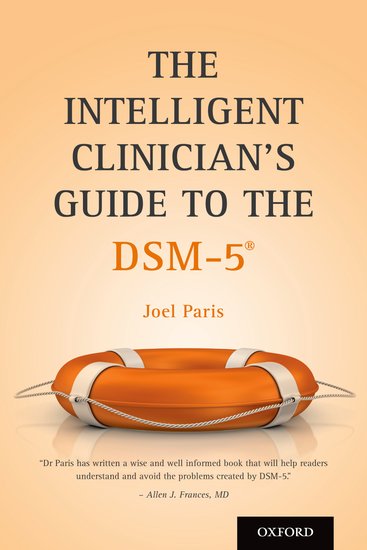By Joel Paris, MD
The Diagnostic and Statistical Manual of Mental Disorders (DSM) is a classification of all diagnoses given to patients by mental health professionals. Since the publication of the third edition in 1980, each edition has been a subject of intense interest to the general public. The current manual, DSM-5, is the first major revision since 1994.
DSM-5 is not, as sometimes claimed, “the bible of psychiatry”. It is not based on a thorough understanding of the causes of mental disorder, which remain largely unknown. Nor does it provide guidance concerning treatment. What DSM does is to allow mental health professionals to communicate with each other by listing criteria by which diagnoses can be made reliable.
When DSM-5 was in the planning stage, there was talk of radical changes, leading to a “paradigm shift”. This did not happen, as the scientific reviewers of proposals for revision insisted that major changes could not be made without very strong scientific evidence. A few changes attracted attention in the media (such as allowing a diagnosis of depression in people suffering from grief). By and large, the manual is not that different from its predecessors.
The problems with DSM-5 are the same as those affecting all earlier editions. If we do not understand what causes mental illness, it is very difficult to classify it. Unfortunately, the use of certain diagnoses is so widespread that people get the impression that categories in psychiatry are as real as hepatitis or multiple sclerosis. They are not. They are simply convenient ways of describing what clinicians see in practice. None of them have a correlation with biomarkers such as blood tests, genes, or brain imaging. They remain entirely dependent on signs and symptoms, which is all that mental health practitioners can currently observe.

The DSM system has led to an inflated prevalence of certain disorders, sometimes producing diagnostic epidemics. These problems affect some of the most common disorders in practice. Thus “major depression” is a very disparate collection of signs and symptoms that cannot be used to determine the correct treatment. Bipolar disorder is being diagnosed in patients who do not have its classical features, and has even been applied to young children. Attention deficit hyperactivity disorder (ADHD) has no definite boundaries, and is being greatly over-diagnosed, both in children and adults. Autism spectrum disorders, once considered rare, are now being seen as among the most common of all conditions that professionals see.
The real problem behind diagnostic epidemics is the failure of the DSM system to distinguish between mental disorder and normality. There is no agreed on definition of mental illness, whose scope has been steadily expanded. This trend is associated with a dangerous over-prescription of drugs that were originally developed for patients with severe and clearcut illnesses.
The DSM system can be described as flawed but necessary. Clinicians need to communicate to each other, and even a wrong diagnosis allows them to do so. However it will require many decades before we know enough about mental illness to produce a truly scientific classification.
Joel Paris is a professor of psychiatry at McGill University (Montreal, Canada), and a research associate at the SMBD-Jewish General Hospital, Montreal. He is the author of 15 books, most recently The Intelligent Clinician’s Guide to the DSM-5®, and 183 peer-reviewed scientific articles.
The OUPblog is running a series of articles on the DSM-5 in anticipation of its launch today, 18 May 2013. Read previous posts: “DSM-5 will be the last” by Edward Shorter, “The classification of mental illness” by Daniel Freeman and Jason Freeman, “Personality disorders in DSM-5” by Donald W. Black, and “American psychiatry is morally challenged” by Michael A. Taylor.
Subscribe to the OUPblog via email or RSS.
Subscribe to only psychology articles on the OUPblog via email or RSS.
Image credit: young woman in a conversation with a consultant or psychologist. Photo by AlexRaths, iStockphoto.


[…] and validity. We also know that people have difficulty understanding this; indeed, a recent blogger suggested that diagnoses are necessary for communication “even if they’re wrong” – a […]
[…] a review. But in the meantime, Dr. Paris has posted on Oxford University Press’s website a brief essay to promote the book. The essay has lots of interesting aspects, and I thought it might be helpful to examine it in […]
[…] So I stand by my “psychiatric diagnoses are unreliable” claim (especially in routine clinical practice, when diagnostic manuals are more decorative than obligatory). And whilst I agree with Dr. Pies that validity is much more important, I worry about reliability when I see prominent psychiatrists suggest, for instance, that “Clinicians need to communicate to each other, and even a wrong diagnosis allows them to do so”. […]
[…] Joel Paris is a professor of psychiatry at McGill University (Montreal, Canada), and a research associate at the SMBD-Jewish General Hospital, Montreal. He is the author of 15 books, most recently The Intelligent Clinician’s Guide to the DSM-5®, and 183 peer-reviewed scientific articles. read his previous blog post “Clinician’s guide to DSM-5.” […]